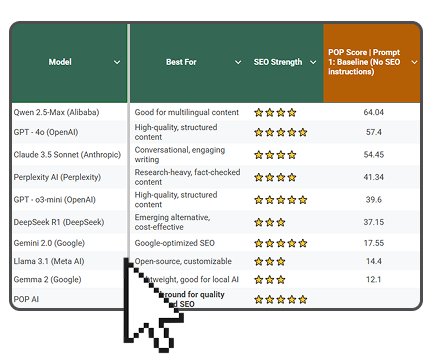Advanced on page SEO made simple.
Powered by POP Rank Engine™
Includes AI Writer
7-day refund guarantee
In today's digital age, having a robust online presence is crucial for any business, including medical practices. One of the most effective ways to improve your online visibility and attract more patients is through search engine optimization (SEO). Specifically, leveraging Google's EEAT (Expertise, Authoritativeness, and Trustworthiness) guidelines can significantly enhance your medical practice's online presence. In this blog, we'll explore how to implement SEO for medical practice and utilize EEAT to boost your visibility.

Which is the best LLM for SEO content?
Get the full Gsheet of the results and scores from our study delivered straight to your inbox.
Understanding EEAT
EEAT stands for Expertise, Authoritativeness, and Trustworthiness. These are the key factors that Google considers when evaluating the quality of a website, particularly in fields where accuracy and reliability are critical, such as healthcare. Let's break down each component:
- Expertise: This refers to the knowledge and skills of the content creators. For medical practices, this means ensuring that your content is written or reviewed by qualified healthcare professionals.
- Authoritativeness: This involves establishing your website as a reliable source of information. This can be achieved through backlinks from reputable sites, positive patient reviews, and recognition from professional organizations.
- Trustworthiness: This is about making your website safe and reliable. Trust can be built through transparent policies, secure connections (HTTPS), and clear contact information.
Optimizing Your Medical Practice Website for SEO
- Keyword Research and Optimization
Conduct thorough keyword research to identify terms potential patients use when searching for medical services. Use tools like Google Keyword Planner, Ahrefs, or SEMrush to find relevant keywords. For example, "SEO for medical practice" is a valuable keyword. Ensure these keywords are naturally incorporated into your website’s content, meta descriptions, titles, and headers.
- Quality Content Creation
High-quality content is the cornerstone of effective SEO. Create informative and engaging content that addresses common patient questions and concerns. Blog posts, FAQs, and patient testimonials are excellent content types. Ensure all content is accurate and up-to-date, and consider having it reviewed by medical professionals to enhance expertise and trustworthiness.
- On-Page SEO
On-page SEO involves optimizing individual web pages to rank higher and earn more relevant traffic. This includes:
- Title Tags and Meta Descriptions: Ensure each page has a unique title tag and meta description that include your primary keywords.
- Header Tags: Use header tags (H1, H2, H3) to structure your content and make it easier for search engines to understand.
- Alt Text for Images: Add descriptive alt text to all images to help search engines index them and improve accessibility.
- Mobile Optimization
With the increasing use of smartphones, ensuring your website is mobile-friendly is crucial. A responsive design that adjusts to different screen sizes will improve user experience and positively impact your SEO rankings.
- Local SEO
For medical practices, local SEO is vital. Optimize your Google My Business profile with accurate contact information, business hours, and location. Encourage satisfied patients to leave positive reviews, as these can significantly impact your local search rankings.
- Backlink Building
Building high-quality backlinks from reputable websites can boost your site’s authority. Reach out to medical directories, local businesses, and professional organizations to get listed or collaborate on content. Guest blogging on relevant sites can also help generate valuable backlinks.
Which is the best LLM for SEO content?
Get the full Gsheet of the results and scores from our study delivered straight to your inbox.

Leveraging EEAT for Better Visibility
1. Showcasing Expertise
To demonstrate expertise, highlight the qualifications and experience of your medical staff on your website. Include detailed bios and credentials for doctors, nurses, and other healthcare providers. Publish articles, research papers, and case studies authored by your staff to showcase their knowledge and skills.
2. Establishing Authoritativeness
Authoritativeness can be established through partnerships and endorsements. Collaborate with other reputable healthcare websites for guest posts and backlinks. Participate in industry forums and online communities to build your reputation. Ensure your content is well-researched and cite reliable sources to back up your claims.
3. Building Trustworthiness
Trustworthiness is crucial for medical websites. Ensure your site has clear privacy policies, terms of service, and disclaimers. Use HTTPS to secure your website and protect patient data. Provide multiple contact options, including phone numbers, email addresses, and physical addresses, to make it easy for patients to reach you.
4. Patient Reviews and Testimonials
Encourage your patients to leave positive reviews on Google, Yelp, and other review platforms. Feature these testimonials prominently on your website. Positive reviews not only build trust but also enhance your local SEO efforts.
5. Regular Updates and Maintenance
Regularly update your website with fresh content and ensure all information is current. Outdated information can harm your credibility and SEO rankings. Conduct regular audits to fix broken links, update software, and ensure your site runs smoothly.
Conclusion
Implementing SEO for your medical practice by leveraging EEAT principles can significantly improve your online visibility and attract more patients. By demonstrating expertise, establishing authoritativeness, and building trustworthiness, you can create a strong online presence that stands out in the competitive healthcare industry. Start by optimizing your content, enhancing your website's technical aspects, and actively engaging with your community to see a noticeable improvement in your search engine rankings.







